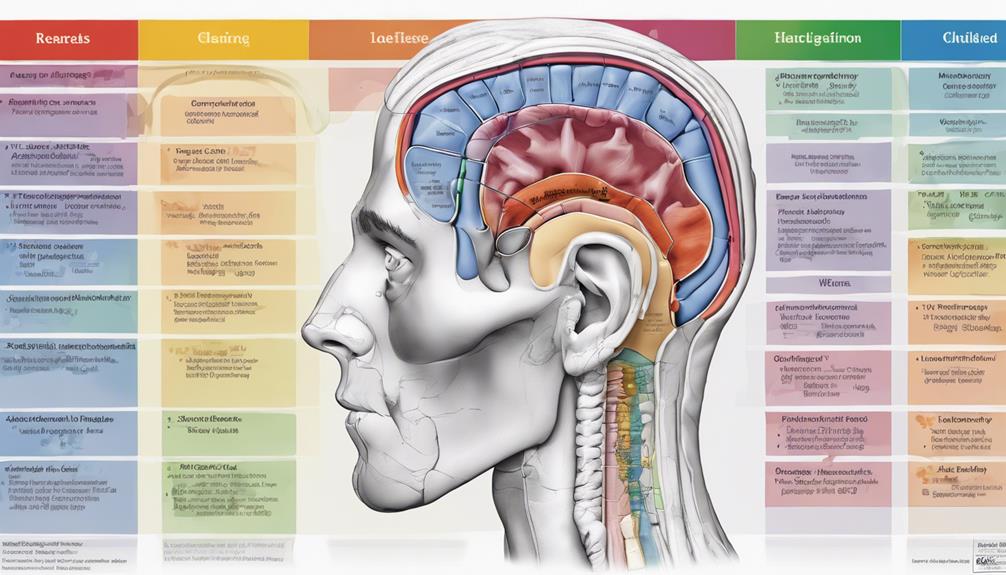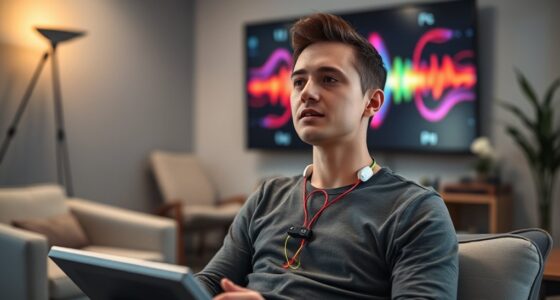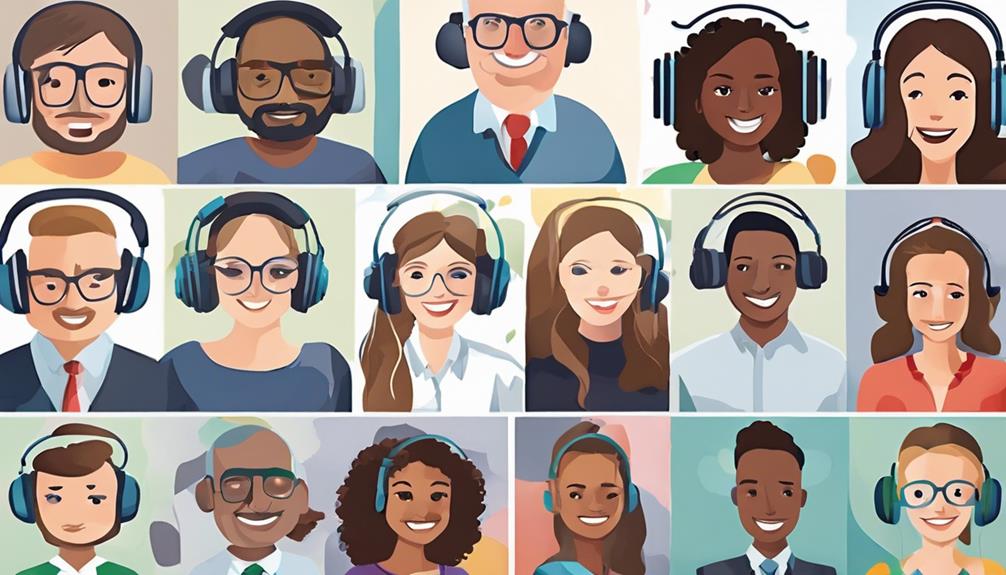As speech therapy continues to evolve, the effectiveness of various techniques in aiding stroke patients' recovery remains a focal point for professionals. Exploring the realm of 7 speech therapy techniques tailored specifically for stroke patients can unveil a multitude of benefits, sparking intrigue into the intricate world of rehabilitation for communication impairments.
Each technique serves as a vital piece in the puzzle of helping stroke survivors regain their voice and confidence. By delving into these strategies, one can truly grasp the transformative power of speech therapy in enhancing the lives of those affected by strokes.
Key Takeaways
- Tongue strengthening exercises improve speech clarity and articulation post-stroke.
- Cognitive-linguistic strategies enhance language skills and communication abilities.
- Oral motor coordination activities rehabilitate mouth muscles for speech production.
- Dysphagia management techniques prevent complications like aspiration pneumonia after a stroke.
Tongue Strengthening Exercises
Engaging in tongue strengthening exercises is essential for stroke patients seeking to improve speech articulation and clarity post-stroke. These exercises, such as In-And-Outs and Side-To-Side movements, are specifically designed to enhance tongue mobility and coordination, ultimately aiding in speech production. By incorporating repetitive sets of movements into their daily routines, stroke survivors can significantly benefit from the effects of these exercises. Regular practice, with at least two sessions per day consisting of 10 repetitions each, plays a crucial role in speech recovery after a stroke.
Tongue strengthening is paramount for overcoming speech difficulties resulting from stroke-related impairments. In the realm of speech therapy for stroke patients, these exercises are indispensable for regaining control and function of the tongue muscles. As individuals commit to these exercises, they empower themselves on the journey to clearer articulation and improved speech clarity, marking significant progress in their post-stroke rehabilitation.
Speech Repetition Techniques
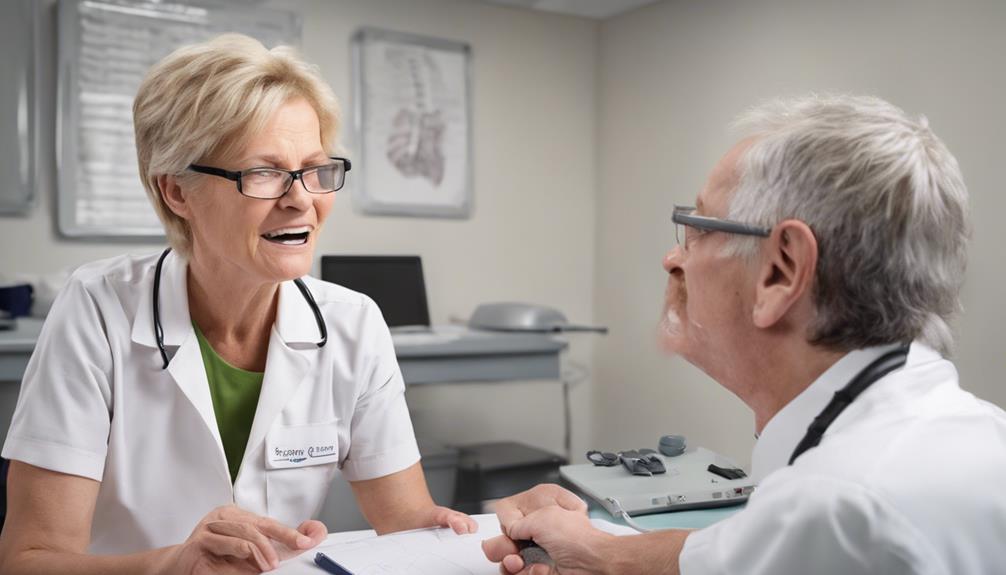
Improving speech clarity and articulation post-stroke involves utilizing speech repetition techniques that strengthen neural pathways in the brain related to speech production.
These exercises, which entail repeating words, phrases, or sentences, play a vital role in aiding recovery by reinforcing the connections necessary for effective communication. Through regular practice, speech repetition techniques not only enhance language comprehension but also improve expression abilities in stroke patients.
By targeting specific speech difficulties such as pronunciation, intonation, and rhythm, these methods help individuals regain control over their speech. Speech therapists often incorporate repetition exercises to build confidence and promote fluency in communication, empowering patients to communicate more effectively.
Embracing these techniques can be a significant step towards restoring speech functions and facilitating better interactions post-stroke.
Cognitive-Linguistic Strategies
Utilizing cognitive-linguistic strategies in speech therapy post-stroke involves targeting cognitive functions essential for language and communication recovery. Memory, attention, problem-solving skills, word retrieval, categorization, sequencing, comprehension, and expression play vital roles in the rehabilitation process.
Here are five ways cognitive-linguistic strategies can benefit stroke patients:
- Improving memory and attention can enhance communication abilities and overall quality of life.
- Enhancing problem-solving skills aids in navigating daily communication challenges effectively.
- Practicing word retrieval techniques assists in finding the right words during conversations.
- Engaging in categorization activities helps organize thoughts for clearer communication.
- Working on sequencing tasks can improve the ability to express ideas cohesively.
Oral Motor Coordination Activities

Oral motor coordination activities are essential for rehabilitating the movement and coordination of mouth muscles used in speech production after a stroke. These activities play a crucial role in helping stroke patients regain control over the intricate movements of the tongue, lips, and jaw necessary for clear speech.
By engaging in exercises like tongue twisters, lip trills, and blowing bubbles, individuals can target specific oral motor skills essential for speech rehabilitation. Such activities not only improve articulation and pronunciation but also enhance overall speech intelligibility.
Through consistent practice and dedication to oral motor coordination activities, stroke patients can experience significant improvements in their oral motor function and speech clarity. These exercises are designed to strengthen the muscles involved in speech production, ultimately leading to enhanced communication abilities.
Communication Skill Building Exercises
When it comes to communication skill building exercises for stroke patients, focusing on vocabulary expansion and articulation practice is key.
These exercises aim to enhance language abilities and speech clarity for individuals recovering from a stroke.
Vocabulary Expansion
In enhancing communication skills for stroke patients, vocabulary expansion exercises play a crucial role in improving word retrieval, comprehension, and expression abilities. Engaging in word association games and naming activities can help expand vocabulary post-stroke. These exercises stimulate cognitive function and promote language growth. Regular practice of vocabulary exercises can improve communication confidence and clarity.
- Word association games aid in connecting words and enhancing memory.
- Naming activities strengthen vocabulary recall and usage.
- Vocabulary expansion exercises provide a creative outlet for expression.
- Building a rich vocabulary fosters better communication interactions.
- Increased language proficiency boosts self-esteem and social engagement.
Articulation Practice
Expanding on vocabulary skills through word association games and naming activities sets a strong foundation for articulation practice, a key component in improving speech clarity and precision for stroke patients.
Articulation exercises aim to strengthen speech muscles, enhance coordination, and address speech difficulties post-stroke. By repeating consonant and vowel sounds, individuals can overcome challenges in articulation, regaining control over speech production and pronunciation.
Speech therapists employ tailored techniques to target specific articulation issues, helping stroke survivors enhance their communication skills. Through these exercises, individuals can work towards clearer speech and improved articulation, ultimately supporting their overall communication abilities.
The focused practice on articulation not only aids in speech rehabilitation but also boosts confidence in daily interactions for stroke patients.
Swallowing Rehabilitation Techniques

When addressing swallowing rehabilitation techniques for stroke patients, we focus on:
- Oral motor exercises
- Swallowing strategies
- Dysphagia management
These approaches help in improving swallowing function and preventing complications like aspiration.
As speech therapists, we aim to enhance the safety and efficiency of swallowing for stroke survivors.
Oral Motor Exercises
Oral motor exercises play a crucial role in enhancing swallowing function for stroke patients by targeting muscle strength and coordination. These exercises are vital for individuals experiencing dysphagia post-stroke, improving control and coordination for safer swallowing.
Speech therapists often integrate oral motor exercises into swallowing rehabilitation programs to aid in the recovery process. Here are some ways these exercises can benefit stroke patients:
- Strengthening weak muscles involved in swallowing
- Enhancing coordination for more effective swallowing
- Improving overall control during the swallowing process
- Providing a structured approach to rehabilitation
- Boosting confidence in eating and drinking
Swallowing Strategies
Swallowing strategies, crucial for stroke patients facing dysphagia challenges, encompass a range of rehabilitation techniques aimed at strengthening throat muscles and improving coordination to ensure safer swallowing post-stroke. These swallowing therapy approaches, such as the Mendelsohn maneuver and effortful swallow, are designed to enhance swallowing function and prevent complications like aspiration pneumonia. By targeting the coordination of swallowing muscles, these techniques play a vital role in choking prevention and overall well-being.
Speech therapists are instrumental in educating both patients and caregivers on implementing these strategies effectively. With a focus on enhancing muscle strength and coordination, swallowing therapy serves as a cornerstone in the rehabilitation journey, promoting safe and efficient swallowing for stroke survivors.
Dysphagia Management
How can dysphagia management techniques improve swallowing function for stroke survivors?
Dysphagia, a common issue post-stroke, impacts many survivors, affecting their ability to swallow safely.
Swallowing rehabilitation focuses on enhancing coordination and strength in swallowing muscles, crucial for preventing aspiration pneumonia.
By implementing strategies like chin tuck exercises, supraglottic swallow, and effortful swallowing, individuals can work towards improving their swallowing function effectively.
Additionally, modified diets and thickened liquids are recommended to decrease the risk of choking and aspiration.
Through personalized dysphagia management plans, speech therapists play a vital role in ensuring individuals can swallow safely and efficiently, enhancing their overall quality of life.
Technology-Assisted Speech Therapy
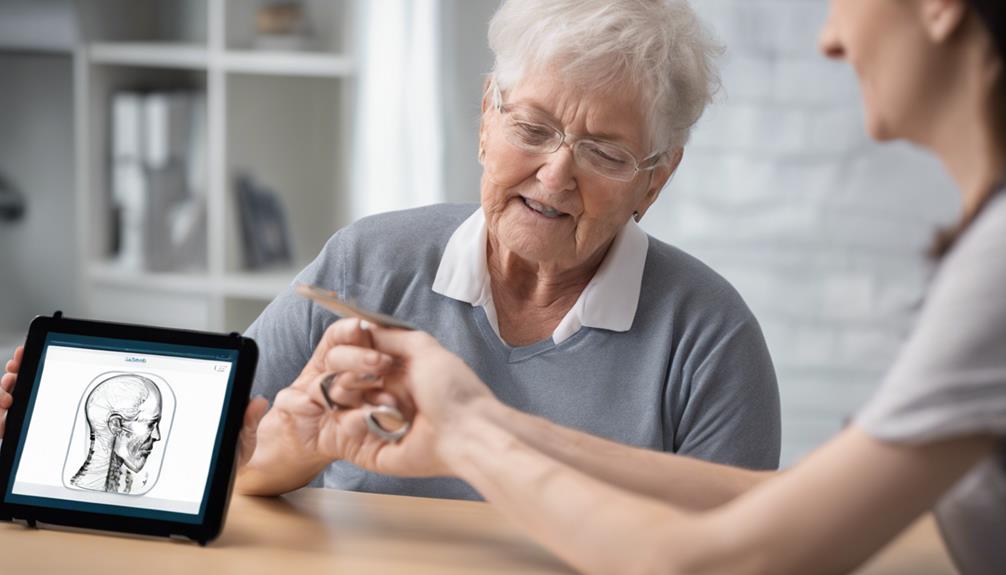
Utilizing modern technology in speech therapy can significantly enhance the rehabilitation process for stroke patients. Mobile apps like Stamurai offer convenient access to speech therapy, allowing individuals to practice speech exercises anytime, anywhere.
Teletherapy has emerged as a valuable tool, enabling remote speech therapy sessions for post-stroke patients who may have difficulty with in-person appointments. Virtual reality tools play a crucial role in simulating various communication scenarios, aiding in speech recovery by providing a safe environment for practice.
Speech recognition software offers stroke patients opportunities for practice and immediate feedback, promoting consistent improvement. Additionally, online resources cater to educational needs in post-stroke speech rehabilitation, providing valuable information and exercises to support recovery.
Incorporating technology into speech therapy not only enhances accessibility but also offers innovative ways to address the unique challenges faced by stroke patients in their journey towards improved communication skills.
Frequently Asked Questions
How Can a Stroke Patient Improve Speech?
We can help a stroke patient improve speech by engaging in regular tongue exercises and practicing facial muscle exercises. Focusing on speech articulation exercises and incorporating language and cognitive exercises can also enhance language skills post-stroke.
What Are 3 Therapies Most People Need After Having a Stroke?
After having a stroke, most people commonly require speech therapy, physical therapy, and occupational therapy for recovery. These therapies help improve communication skills, regain strength and mobility, and enhance daily living skills.
Each therapy plays a crucial role in holistic rehabilitation and recovery. It's essential to have a comprehensive approach to address the various aspects affected by a stroke and promote overall well-being.
How Long Does It Take a Stroke Patient to Regain Speech?
Recovery time for speech after a stroke varies based on factors like stroke severity, therapy type, and patient dedication. Some may see progress in weeks, while others take longer. Research supports intensive therapy for faster improvement.
Brain damage, health conditions, and overall health affect recovery speed. Early intervention and consistent practice are vital for speech recovery. Each person's journey is unique, and we aim to provide support and guidance throughout.
What Not to Say to a Stroke Patient?
We should steer clear of phrases that unintentionally belittle stroke patients' struggles, like 'Just try harder' or 'You sound fine to me.' Let's remember, it's crucial to show empathy and understanding in our conversations with them.
Conclusion
In conclusion, speech therapy offers a range of techniques to help stroke patients improve their communication skills and quality of life.
By incorporating tongue strengthening exercises, speech repetition techniques, and cognitive-linguistic strategies, patients can make significant progress in their recovery journey.
Remember, 'practice makes perfect' – with consistent effort and guidance from speech therapists, stroke patients can regain confidence in their ability to communicate effectively.


